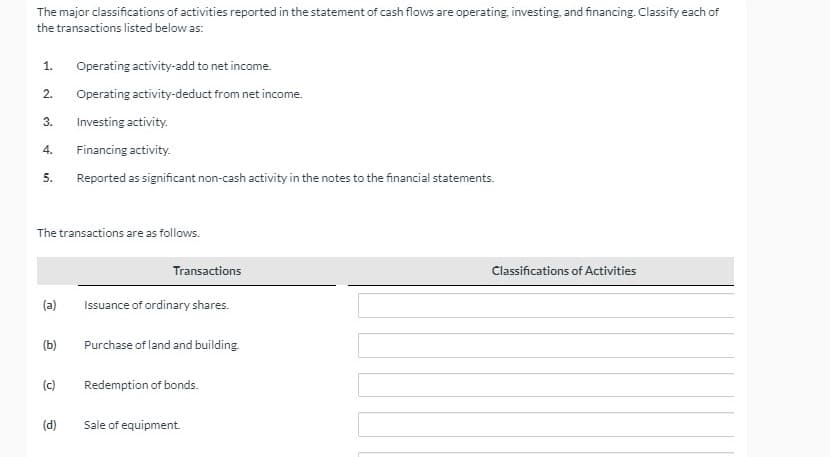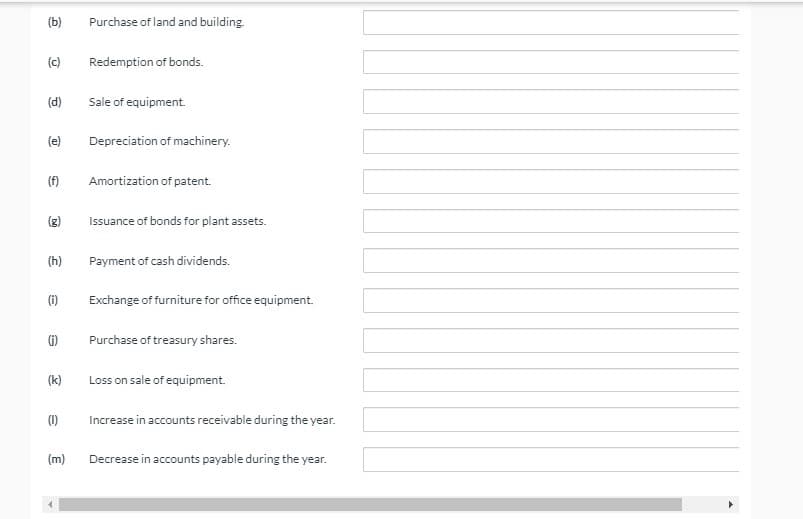r classifications of activities reported in the statement of cash flows
Intermediate Accounting: Reporting And Analysis
3rd Edition
ISBN:9781337788281
Author:James M. Wahlen, Jefferson P. Jones, Donald Pagach
Publisher:James M. Wahlen, Jefferson P. Jones, Donald Pagach
Chapter21: The Statement Of Cash Flows
Section: Chapter Questions
Problem 1P: Classification of Cash Flows A company's statement of cash flows and the accompanying schedule of...
Related questions
Question

Transcribed Image Text:The major classifications of activities reported in the statement of cash flows are operating, investing, and financing. Classify each of
the transactions listed below as:
1.
Operating activity-add to net income.
2.
Operating activity-deduct from net income.
3.
Investing activity.
4.
Financing activity.
5.
Reported as significant non-cash activity in the notes to the financial statements.
The transactions are as follows.
Transactions
Classifications of Activities
(a)
Issuance of ordinary shares.
(b)
Purchase of land and building.
(c)
Redemption of bonds.
(d)
Sale of equipment.

Transcribed Image Text:(b)
Purchase of land and building.
(c)
Redemption of bonds.
(d)
Sale of equipment.
(e)
Depreciation of machinery.
(f)
Amortization of patent.
(g)
Issuance of bonds for plant assets.
(h)
Payment of cash dividends.
(i)
Exchange of furniture for office equipment.
G)
Purchase of treasury shares.
(k)
Loss on sale of equipment.
(1)
Increase in accounts receivable during the year.
(m)
Decrease in accounts payable during the year.
Expert Solution
This question has been solved!
Explore an expertly crafted, step-by-step solution for a thorough understanding of key concepts.
Step by step
Solved in 2 steps

Recommended textbooks for you

Intermediate Accounting: Reporting And Analysis
Accounting
ISBN:
9781337788281
Author:
James M. Wahlen, Jefferson P. Jones, Donald Pagach
Publisher:
Cengage Learning

Managerial Accounting
Accounting
ISBN:
9781337912020
Author:
Carl Warren, Ph.d. Cma William B. Tayler
Publisher:
South-Western College Pub

Cornerstones of Financial Accounting
Accounting
ISBN:
9781337690881
Author:
Jay Rich, Jeff Jones
Publisher:
Cengage Learning

Intermediate Accounting: Reporting And Analysis
Accounting
ISBN:
9781337788281
Author:
James M. Wahlen, Jefferson P. Jones, Donald Pagach
Publisher:
Cengage Learning

Managerial Accounting
Accounting
ISBN:
9781337912020
Author:
Carl Warren, Ph.d. Cma William B. Tayler
Publisher:
South-Western College Pub

Cornerstones of Financial Accounting
Accounting
ISBN:
9781337690881
Author:
Jay Rich, Jeff Jones
Publisher:
Cengage Learning

Financial Accounting: The Impact on Decision Make…
Accounting
ISBN:
9781305654174
Author:
Gary A. Porter, Curtis L. Norton
Publisher:
Cengage Learning

Financial Accounting
Accounting
ISBN:
9781337272124
Author:
Carl Warren, James M. Reeve, Jonathan Duchac
Publisher:
Cengage Learning

Financial And Managerial Accounting
Accounting
ISBN:
9781337902663
Author:
WARREN, Carl S.
Publisher:
Cengage Learning,